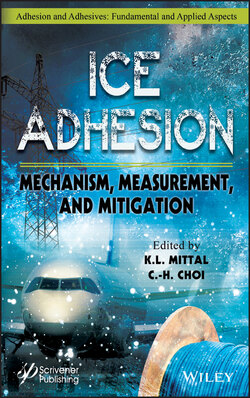Читать книгу Ice Adhesion - Группа авторов - Страница 26
1.4.2 The Origin of Ice’s Liquid-Like Layer
ОглавлениеSince Faraday’s 1859 suggestion of a liquid-like layer existing on ice, there has been much speculation whence this film arrives [129]. This subsection will present the major theories for the presence of the liquid-like layer, which is still under debate. For a more-thorough review of the subject, the interested reader is referred to the work of Petrenko and Whitworth [140]. The formation of an inherent liquid-like layer on ice has been suggested over the years to be derived from: electrostatic interactions [141, 142], surface free energy minimization [143, 144], subsurface pressure melting [145, 146], and the vibration and rotation of surface molecules [147–150].
Pressure melting has been used to explain the low friction coefficient of ice since it was first suggested by Reynolds in 1900 [131]. The theory being that external pressure applied to the surface of ice will lead to a depression of the melting point temperature, and thus melting of the ice and an increase in the lubricating liquid-like layer thickness. However, while pressure melting may contribute to the formation of a lubricating layer between ice and a solid slider at temperatures close to the melting point, this phenomenon cannot explain ice’s low friction at lower temperatures. Calculations show that the melting temperature of ice can only be lowered by 0.1 to 1 K, depending on the slider [133].
Rather than pressure melting, Bowden, Hughes and Desch [132] suggested that frictional heating is the most important contributor to the low friction coefficient of ice. When a slider is translated relative to an ice surface with which it is mated, heat is generated. A portion of the generated heat will raise the temperature at the contacting asperities up to the melting temperature of ice. Once the melting temperature is attained, the ice surface will begin to locally melt at the contacting asperities, forming a non-continuous film of water. As discussed in Section 1.4.1, the liquid film will contribute to the lubrication of the slider on ice. Bowden, Hughes and Desch note that as the ambient temperature is raised, the lubricating melt layer can become continuous [132].
